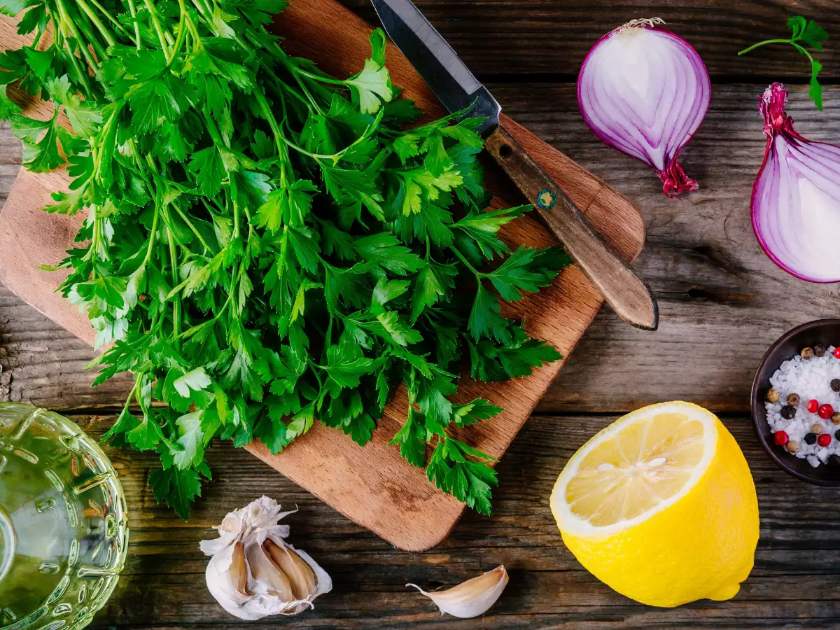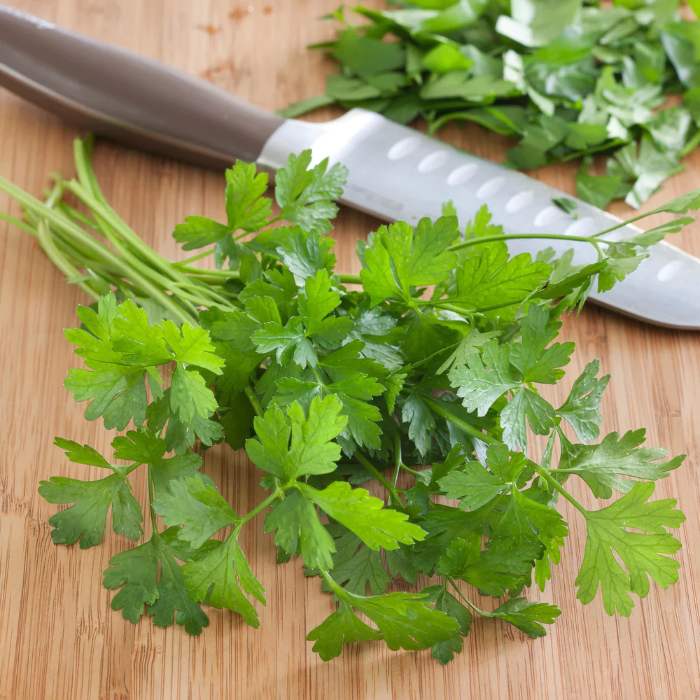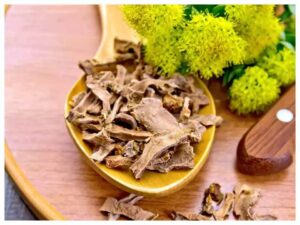The Mysterious Origins of Parsley
A Tale of Ancient Lore and Mythology
Parsley, a fragrant and versatile herb used in cuisines worldwide, has a rich and complex history. Its origins are shrouded in mystery and mythology, with legends dating back thousands of years. While it is unclear exactly when and where parsley was first discovered, there are several fascinating stories that shed light on its mythical beginnings.
The Ancient Greeks and Romans
One of the most prominent tales surrounding parsley’s origins comes from ancient Greek and Roman mythology. According to legend, parsley was born of the blood of Archemorus, a Greek hero who was killed by a serpent. The plant is said to have grown from his blood, symbolizing regeneration and new life. In ancient Greece, parsley was often associated with death and the afterlife, and was used to adorn tombs and honor the dead.
The Romans also had a deep appreciation for parsley, believing it to have medicinal properties and using it to flavor their food. The poet Horace wrote of parsley in his works, praising its ability to freshen breath and soothe indigestion. The famous Roman cookbook, Apicius, contains several recipes featuring parsley, including a dish of parsley and almonds.
Parsley in the Middle Ages
During the Middle Ages, parsley continued to be valued for its medicinal properties. The famous physician Avicenna included parsley in his medical treatises, recommending it as a treatment for kidney stones and other ailments. In Europe, parsley was used to flavor soups, stews, and other dishes, and was also believed to have protective properties. It was often hung in doorways to ward off evil spirits and was sometimes even carried in pouches as a protective talisman.
The Renaissance and Beyond
In the Renaissance, parsley continued to be valued for both its culinary and medicinal properties. The famous herbalist Nicholas Culpeper wrote of parsley in his works, praising its ability to cleanse the blood and strengthen the kidneys. In the 18th century, parsley was used by the famous physician Benjamin Rush to treat a variety of ailments, including epilepsy and jaundice.
Today, parsley remains a popular herb in many parts of the world, and is used in a wide variety of dishes, from tabbouleh to chimichurri. It is valued for its fresh, bright flavor and its ability to enhance the taste of other ingredients. Parsley is also still used in traditional medicine, particularly in the treatment of urinary tract infections and other kidney-related issues.
The Search for Parsley’s Origins
Despite its widespread use and long history, the exact origins of parsley remain unclear. Some historians believe that the herb was first cultivated in the Mediterranean region, while others argue that it may have originated in Asia. There are records of parsley being used in ancient Egypt and Persia, and it is possible that it was brought to Europe by traders and travelers along the Silk Road.
In recent years, scientists have begun studying the genetic makeup of parsley in an effort to uncover its origins. One study conducted by researchers at the University of California, Davis, found that parsley is closely related to other herbs such as fennel, dill, and coriander, and may have evolved from a common ancestor. However, the exact origins of that ancestor remain a mystery.
Conclusion
While the origins of parsley may never be fully known, its place in history and mythology is secure. From ancient Greek and Roman legends to modern-day culinary and medicinal uses, parsley has been valued and appreciated for thousands of years. Whether used to flavor a dish or to treat a medical condition, this versatile herb has earned its place in the pantheon of botanical wonders.

The Health Benefits of Parsley: A Nutritious Herb
Introduction
Parsley is a popular herb known for its bright green color and fresh flavor. While it is commonly used as a garnish or ingredient in many dishes, parsley is also a rich source of essential vitamins and minerals, and has many potential health benefits. In this article, we will explore the various health benefits of parsley, as well as its nutritional content and how to incorporate it into your diet.
Nutritional Content of Parsley
Parsley is a nutrient-dense herb, rich in vitamins and minerals. One cup (30 grams) of chopped fresh parsley contains:
- Vitamin K: 574% of the Recommended Daily Intake (RDI)
- Vitamin C: 62% of the RDI
- Vitamin A: 52% of the RDI
- Folate: 17% of the RDI
- Iron: 14% of the RDI
- Calcium: 8% of the RDI
- Potassium: 6% of the RDI
In addition to these essential vitamins and minerals, parsley also contains flavonoids and other beneficial plant compounds, which we will explore in more detail below.
1. May Support Heart Health
Parsley may have a beneficial effect on heart health. The flavonoids in parsley, including apigenin and luteolin, have been shown to have anti-inflammatory and antioxidant properties, which may help reduce the risk of heart disease. In addition, the high levels of vitamin K in parsley may help improve blood clotting and prevent the buildup of plaque in the arteries.
2. May Help Regulate Blood Sugar
Parsley may also help regulate blood sugar levels. One study found that supplementing with parsley extract improved insulin sensitivity in people with diabetes. Another study found that consuming parsley juice before a meal reduced blood sugar levels in people with type 2 diabetes.
3. May Have Anti-Cancer Properties
Parsley contains a variety of plant compounds that may have anti-cancer properties. For example, the flavonoid apigenin has been shown to inhibit the growth of cancer cells in the laboratory. In addition, parsley contains a compound called myristicin, which has been shown to have anti-cancer properties in animal studies.
4. May Support Digestive Health
Parsley may also have a beneficial effect on digestive health. The compounds in parsley have been shown to have anti-inflammatory and anti-spasmodic properties, which may help reduce digestive discomfort. In addition, parsley contains a high level of fiber, which can help promote regular bowel movements and improve overall digestive health.
5. May Have Anti-Inflammatory Properties
Parsley has been shown to have anti-inflammatory properties, which may help reduce the risk of chronic diseases such as heart disease, cancer, and arthritis. The flavonoids in parsley, including luteolin and apigenin, have been shown to inhibit the production of inflammatory cytokines in the body.
6. May Help Improve Bone Health
Parsley is a rich source of vitamin K, which is important for bone health. Vitamin K helps improve bone density and reduce the risk of fractures. In addition, parsley contains calcium and other minerals that are important for bone health.
7. May Improve Immune Function
Parsley contains high levels of vitamin C, which is important for immune function. Vitamin C helps stimulate the production of white blood cells, which are important for fighting off infections and diseases.
8. May Help Improve Skin Health
Parsley may also have a beneficial effect on skin health. The flavonoids in parsley, including apigenin and luteolin, have been shown to have anti-inflammatory and antioxidant properties, which may help reduce inflammation and oxidative stress in the skin. In addition, parsley contains high levels of vitamin C, which is important for collagen production and skin health.
How to Incorporate Parsley into Your Diet
There are many ways to incorporate parsley into your diet. Here are a few ideas:
- Add chopped parsley to salads or soups for a fresh burst of flavor.
- Use parsley as a garnish for meat or fish dishes.
- Blend parsley into a smoothie for an extra nutrient boost.
- Make a parsley pesto by blending parsley, garlic, pine nuts, and olive oil.
- Add parsley to your favorite hummus recipe for a fresh twist.
When choosing parsley, look for fresh, bright green leaves. Store it in the refrigerator, wrapped in a damp paper towel, for up to a week.
Conclusion
Parsley is a nutrient-dense herb with many potential health benefits. It may help support heart health, regulate blood sugar, and have anti-cancer and anti-inflammatory properties. In addition, parsley is a rich source of essential vitamins and minerals, including vitamin K, vitamin C, and iron. To incorporate parsley into your diet, try adding it to salads, soups, or as a garnish for meat or fish dishes. As with any herb or supplement, it is important to talk to your healthcare provider before adding parsley to your diet, especially if you are pregnant or taking medications.
The Nutritional Components and Core Ingredients of Parsley
Parsley is a nutrient-dense herb that contains a wide variety of vitamins, minerals, and other nutrients. Here are some of the key nutritional components of parsley:
Vitamins
Parsley is particularly rich in vitamin K, which is important for blood clotting and bone health. It also contains high levels of vitamin C, which is essential for immune function and collagen production. In addition, parsley is a good source of vitamin A, which is important for vision, skin health, and immune function.
Minerals
Parsley is also a good source of several important minerals, including iron, calcium, and potassium. Iron is essential for the production of hemoglobin, a protein that carries oxygen in the blood. Calcium is important for bone health, while potassium is important for heart health and proper muscle function.
Other Nutrients
Parsley also contains a variety of other nutrients, including flavonoids and other plant compounds. Flavonoids, such as apigenin and luteolin, have anti-inflammatory and antioxidant properties and may have a beneficial effect on heart health and other chronic diseases.
Core Ingredients of Parsley
In addition to its nutritional components, parsley contains a variety of core ingredients that contribute to its unique flavor and health benefits. Here are some of the key core ingredients of parsley:
Essential Oils
Parsley contains essential oils that give it its distinctive flavor and aroma. These oils include myristicin, apiol, and eugenol, which are also found in other herbs and spices, such as nutmeg and cinnamon.
Chlorophyll
Parsley is rich in chlorophyll, a green pigment found in plants that is important for photosynthesis. Chlorophyll has been shown to have a variety of potential health benefits, including anti-inflammatory and antioxidant properties.
Fiber
Parsley is also a good source of fiber, which is important for digestive health. Fiber helps promote regular bowel movements and may also help reduce the risk of certain chronic diseases, such as heart disease and diabetes.
Health Benefits of Parsley
Parsley has a wide range of potential health benefits, thanks to its nutrient density and unique combination of core ingredients. Here are some of the key health benefits of parsley:
Anti-Inflammatory Properties
Parsley contains flavonoids and other plant compounds that have anti-inflammatory properties. These compounds may help reduce inflammation in the body and reduce the risk of chronic diseases such as heart disease, cancer, and arthritis.
Antioxidant Properties
Parsley also has antioxidant properties, thanks to the flavonoids and other plant compounds it contains. Antioxidants help protect the body from oxidative stress, which can damage cells and contribute to the development of chronic diseases.
Digestive Health
Parsley is a good source of fiber, which is important for digestive health. Fiber helps promote regular bowel movements and may also help reduce the risk of certain digestive disorders, such as constipation and diverticulitis.
Heart Health
Parsley contains flavonoids and other plant compounds that may have a beneficial effect on heart health. These compounds may help reduce inflammation and oxidative stress in the arteries, which can lead to the development of heart disease. In addition, the high levels of vitamin K in parsley may help improve blood clotting and prevent the buildup of plaque in the arteries.
Bone Health
Parsley is a rich source of vitamin K, which is important for bone health. Vitamin K helps improve bone density and reduce the risk of fractures. In addition, parsley contains calcium and other minerals that are important for bone health.
Immune Function
Parsley contains high levels of vitamin C, which is important for immune function. Vitamin C helps stimulate the production of white blood cells, which are important for fighting off infections and diseases.
Skin Health
Parsley may also have a beneficial effect on skin health. The flavonoids in parsley, including apigenin and luteolin, have been shown to have anti-inflammatory and antioxidant properties, which may help reduce inflammation and oxidative stress in the skin. In addition, parsley contains high levels of vitamin C, which is important for collagen production and skin health.

Methods for Consuming Parsley: Delicious and Nutritious
Fresh Parsley
One of the simplest ways to consume parsley is to use it fresh. Here are a few ideas for incorporating fresh parsley into your diet:
As a Garnish
Fresh parsley makes a beautiful and flavorful garnish for a wide variety of dishes, from soups and stews to pasta and grilled meats. Simply chop up some fresh parsley and sprinkle it over your dish before serving.
In Salads
Fresh parsley is a delicious addition to salads, adding a bright, fresh flavor and a pop of color. Combine fresh parsley with other herbs, such as mint and basil, for a flavorful and nutritious salad.
In Smoothies
Parsley can also be added to smoothies for an extra boost of nutrition. Try blending fresh parsley with kale, spinach, and other greens for a nutritious and refreshing drink.
Dried Parsley
Dried parsley is another convenient and versatile way to incorporate this nutritious herb into your diet. Here are a few ideas for using dried parsley:
In Soups and Stews
Dried parsley is a great addition to soups and stews, adding flavor and nutrition to your favorite recipes. Simply sprinkle some dried parsley into your soup or stew as it cooks.
In Dips and Spreads
Dried parsley can also be added to dips and spreads for a burst of flavor. Mix some dried parsley into your favorite hummus or guacamole recipe for a fresh and nutritious twist.
In Seasoning Blends
Dried parsley is a common ingredient in many seasoning blends, such as Italian seasoning and herbes de Provence. Use these blends to add flavor to your favorite dishes, from roasted vegetables to grilled meats.
Parsley Tea
Parsley tea is another delicious and nutritious way to consume this herb. Here’s how to make parsley tea:
Ingredients
- 1 bunch fresh parsley
- 4 cups water
- Honey or lemon, to taste (optional)
Instructions
- Wash the parsley and chop it into small pieces.
- Bring the water to a boil in a medium-sized pot.
- Add the chopped parsley to the boiling water.
- Reduce the heat to low and let the parsley steep for 10-15 minutes.
- Remove the pot from the heat and strain the parsley from the tea.
- Add honey or lemon to taste, if desired.
Parsley tea is a refreshing and nutritious drink that can be enjoyed hot or cold.
Parsley Recipes
If you’re looking for some creative and delicious ways to incorporate parsley into your diet, here are a few recipe ideas to try:
Parsley Pesto
Ingredients:
- 2 cups fresh parsley leaves, packed
- 1/2 cup walnuts
- 2 cloves garlic
- 1/2 cup grated Parmesan cheese
- 1/2 cup olive oil
- Salt and pepper, to taste
Instructions:
- Combine the parsley, walnuts, garlic, and Parmesan cheese in a food processor.
- Pulse the mixture until it is finely chopped.
- With the food processor running, slowly add the olive oil until the mixture is smooth.
- Season the pesto with salt and pepper to taste.
Parsley pesto is a delicious and nutritious alternative to traditional basil pesto. Serve it over pasta or spread it on toast for a flavorful and healthy snack.
Parsley and Chickpea Salad
Ingredients:
- 1 can chickpeas, drained and rinsed
- 1/2 red onion, diced
- 1/2 cup chopped fresh parsley
- 1/4 cup chopped fresh mint
- 1/4 cup chopped fresh cilantro
- 1/4 cup olive oil
- 1 lemon, juiced
- Salt and pepper, to taste
Instructions:
- Combine the chickpeas, red onion, parsley, mint, and cilantro in a large bowl.
- In a small bowl, whisk together the olive oil, lemon juice, salt, and pepper.
- Pour the dressing over the chickpea mixture and toss to coat.
- Serve the salad chilled or at room temperature.
This chickpea salad is a flavorful and protein-packed dish that is perfect for a healthy lunch or dinner.
Parsley and Quinoa Stuffed Bell Peppers
Ingredients:
- 4 bell peppers
- 1 cup quinoa, cooked
- 1/2 cup chopped fresh parsley
- 1/4 cup chopped fresh mint
- 1/4 cup chopped fresh cilantro
- 1/4 cup chopped walnuts
- 1/4 cup crumbled feta cheese
- Salt and pepper, to taste
Instructions:
- Preheat the oven to 375°F.
- Cut off the tops of the bell peppers and remove the seeds and membranes.
- In a large bowl, combine the quinoa, parsley, mint, cilantro, walnuts, and feta cheese.
- Season the mixture with salt and pepper to taste.
- Stuff the bell peppers with the quinoa mixture and place them in a baking dish.
- Bake the stuffed peppers for 25-30 minutes, or until the peppers are tender and the filling is heated through.
These stuffed bell peppers are a nutritious and delicious meal that is perfect for a healthy dinner.
Conclusion
Parsley is a nutritious and versatile herb that can be used in a variety of different ways. From fresh parsley in salads and smoothies to dried parsley in seasoning blends, there are many ways to incorporate this herb into your diet. Parsley tea is another delicious and nutritious way to consume this herb. And with recipes like parsley pesto, chickpea salad, and stuffed bell peppers, you can enjoy the delicious flavor and health benefits of parsley in a variety of different dishes.
Potential Side Effects and When to Avoid Taking Parsley
Here are some of the potential side effects of parsley:
Allergic Reactions
Some people may be allergic to parsley or other members of the Apiaceae family, such as carrots, celery, and fennel. Symptoms of an allergic reaction may include itching, swelling, and difficulty breathing.
Kidney Damage
Parsley contains high levels of oxalates, which can contribute to the formation of kidney stones in some people. People with a history of kidney stones or kidney disease should avoid consuming large amounts of parsley.
Blood Clotting
Parsley contains high levels of vitamin K, which can interfere with blood clotting. People who are taking blood-thinning medications, such as warfarin, should be cautious when consuming parsley and should consult with their healthcare provider before doing so.
Stomach Upset
Consuming large amounts of parsley may cause stomach upset, such as nausea and diarrhea, in some people.
When to Avoid Taking Parsley
Here are some situations in which it may be best to avoid taking parsley:
Pregnancy and Breastfeeding
Parsley may stimulate uterine contractions and should be avoided by pregnant women, as it may lead to complications. Nursing mothers should also be cautious when consuming parsley, as its effects on infants are not yet fully understood.
Surgery
As mentioned earlier, parsley may interfere with blood clotting. People who are scheduled to undergo surgery should avoid consuming large amounts of parsley in the days leading up to the procedure.
Kidney Disease
As mentioned earlier, parsley contains high levels of oxalates, which can contribute to the formation of kidney stones in some people. People with a history of kidney stones or kidney disease should avoid consuming large amounts of parsley.
Conclusion
While parsley is a nutritious and versatile herb that can be used in a variety of different ways, it is important to be aware of its potential side effects and when to avoid taking it. From allergic reactions to kidney damage and blood clotting, there are several risks associated with consuming large amounts of parsley. Pregnant and breastfeeding women, people with kidney disease or a history of kidney stones, and those scheduled for surgery should be particularly cautious when consuming parsley. As always, it is important to talk to your healthcare provider before making any changes to your diet or supplement routine.






